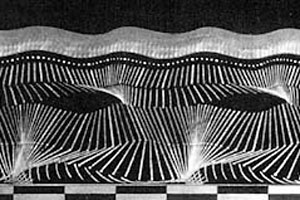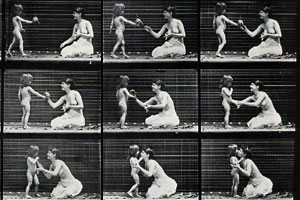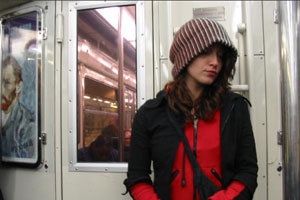"New Media" is a woefully malleable term that generally means "newer than film." Computers are usually involved. But of course "new" is a vague and relative adjective not inherently related to film or computers. New media in its truest sense is simply media that communicates in a new way, a way that previous media could not. By this definition, Etienne-Jules Marey's chronophotography was new media, as was film which followed it. By the same measure, David Crawford's "Stop Motion Studies" series is new media in the truest sense, because like Marey, Crawford is exploring the liminal timescape between still photography and film. What makes "Stop Motion Studies" especially "new" is its peculiar addition of randomizing software.
Crawford's microcosmic photographic studies of (mostly) people (mostly) riding on subways might initially seem like looping micro-films. But upon closer inspection, one realizes that the animations never actually loop. Imagine a slide projector tray filled with anywhere between three to eight slides. The projector displays these same slides infinitely, but always in random order. The projector also randomizes the duration each slide is displayed, anywhere from .03 seconds to .3 seconds (give or take a bit). Finally, all the slides in the tray are of the same subject, all photographed within a limited time frame (less than two minutes). This roughly approximates the mechanics of what Crawford has termed "algorithmic montage." The result is a kind of stochastic motion study more akin to chronophotography than film; but with a distinct, non-linear twist.
Chronophotography was intent upon peering into previously invisible sequences of micro-moments in order to unpack the mysteries of bodies in motion through time. In Crawford's own words, "The work of... Marey compels us to open up, inhabit, and reconsider the density and wonder of the natural world by nature of its interpretation and interpolation of time." [1] Marey was not out to replicate the illusion of motion. On the contrary, he sought to demystify its illusion so that he might better contemplate its subtleties in stasis, at leisure. In this sense, chronophotography is at odds with film -- a kind of dissection without any attempt at simulation. D.W. Griffith and his ilk found the illusion of simulation so captivating, they refashioned the research tool that film might have become into the spectacularized storytelling medium that narrative Hollywood film has become. Film increased; chronophotography decreased.
Such is the now familiar tale of advances in technology rendering previous technological experiments irrelevant. But experiments have a way of resurfacing in technological cycles, because each new medium comes with its own set of aesthetic limitations. In Crawford's case, he was forced by the limitations (bandwidth) of his new technology (the internet) to minimalistically re-examine the original themes of chronophotography from a post-film perspective. Bandwidth limitations in 2002 made Hollywood-genre web video an impossibility, so Crawford took a novel approach. He began experimenting with a digital still camera in burst mode. It could take up to 64 frames per minute. Hardly film quality. Furthermore, 64 high resolution images would take a prohibitive time to download. Part of the solution was to select 3-8 quintessential frames from each batch.
A major obstacle still remained: how to animate these few frames in a way that somehow created a semblance of motion over time? Simply displaying the few frames in chronological order at a set rate would result in what would only seem like crippled film. The solution was Macromedia Flash software with its ActionScript programming language. Crawford was able to program the software to randomize his frame order and frame duration. This resulted in a re-animation of the original static images that refuses both Russian Avant-Garde and Narrative Hollywood film conventions. Whereas the goal of a Hollywood epic like El Cid is to distill a lifetime of events into a few hours, the goal of Crawford's work is to expand a micro-moment into infinity. If, as Crawford observes, "Marey's chronophotographs flourished in the tiny space between the still and the moving image," [2] then "Stop Motion Studies" re-inhabits that tiny space, animates it non-linearly, and thus explores it indefinitely.
Crawford's method of using software to randomize this animation process is admittedly a form of artifice, but no more so than film projected at 30 frames per second is a form of artifice. And since fiction is a lie that tells the truth, Crawford's fictive "new media" genre of stochastic animation seems in many ways more "truthful" than documentary film or photojournalistic still photography. What aspects of the real does "Stop Motion Studies" reveal? First, it reveals the compressed nature of modern space that has become all but invisible to us. Second, it reveals alarming and disarming characteristics of time -- time as a construction of human consciousness rather than time as a divisible ontological entity. Finally, and most apparently, "Stop Motion Studies" affords a unique glimpse into the people who are its subjects -- a window into their souls previously invisible to both film and still photography. Crawford's project is ultimately less about subways and cities and film history and computer software than it is about human souls in space and time.
Space
"A road is a flattened-out wheel, rolled up in the belly of an airplane."
- Marshall McLuhan [3]
The micro-scenes in "Stop Motion Studies" take place largely on subway trains, and this transitory "stage" is the perfect locale for exploring the subjectivity of time. The fast speed of the trains provides a visual foil for the slow speed of the people on the trains. The people may move very little within their few allotted frames, while outside the world races past in a blur. Yet since the frames are displayed randomly, any sense of continual, linear motion is lost. The trains literally appear to be going nowhere fast. Like Zeno's paradoxical arrow, the trains are perpetually in motion, and yet they never arrive. This underscores the empathy we feel for the passengers who are trapped in a kind of modern purgatory -- an in-between time/space they perfunctorily inhabit on their way from "somewhere" to "somewhere else."

frame from "Stop Motion Studies": Series #8, Sequence #2.
Crawford's stochastic animations have a way of ephemerizing even the people themselves. In one frame, a woman is a solid figure, and suddenly in the next she's a blur. The overall effect is reminiscent of Ezra Pound's "In a Station of the Metro" -- "The apparition of these faces in the crowd;/ Petals on a wet, black bough." Back and forth the woman mysteriously transitions. Neither frame is given chronological or hierarchical primacy. Is the woman "really" there or gone? She is perpetually both. In this sense, "Stop Motion Studies" becomes a formal tool for analyzing, unpacking, and coming to terms with the extreme compressions and expansions of "standard" space/time that modern modes of transportation have thrust upon us.
Still photography is impotent to unpack and analyze such fluidities of time. It freezes the instant to such a point that all time is removed (except for the residual symbolic blur). Standard film is likewise impotent to objectively analyze such relative contractions and expansions of time, because film itself (whether "real-time," slow-motion, fast-forward, or time-lapsed) is always subject to a mechanical version of artificially uniform, linear time. As Paul Virilio says, "Cinema is the end in which the dominant philosophies and arts have come to confuse and lose themselves, a sort of primordial mixing of the human soul and the languages of the motor-soul." [4] Just as a well-trained son wouldn't publicly criticize his father, the motor-driven projector spool is faithful to the "reality" of the motor-driven wheel. It takes a new medium like algorithmic montage to re-present such fluidities of time and space with a more penetrating, dispassionate eye.
Time
"Human existence de Selby has defined as 'a succession of static experiences each infinitely brief', a conception which he is thought to have arrived at from examining some old cinematograph films which belonged probably to his nephew [These are evidently the same films which he mentions... as having 'a strong repetitive element' and as being 'tedious'. Apparently he had examined them patiently picture by picture and imagined that they would be screened in the same way, failing at that time to grasp the principle of the cinematograph.] From this premise he discounts the reality or truth of any progression or serialism in life, denies that time can pass as such in the accepted sense and attributes to hallucinations the commonly experienced sensation of progression as, for instance, in journeying from one place to another or even 'living'... Thus motion is also an illusion. He mentions that almost any photograph is conclusive proof of his teachings."
- The narrator from The Third Policeman [5]
de Selby is a fictional character, nevertheless I wonder what he would have made of "Stop Motion Studies." Would he have discovered in it something more than a mere "succession of static experiences?" "Stop Motion Studies" is unique in that it is simultaneously momentary and eternal. How does one discover infinity in a microsecond? Again we're back to Zeno's paradoxes. According to the professor from Haruki Murakami's Hard-Boiled Wonderland and the End of the World, "Expandin' human time doesn't make you immortal; it's subdividin' time that does the trick." [6]
William Blake's "Auguries of Innocence" famously begins:
To see a World in a Grain of Sand
And a Heaven in a Wild Flower,
Hold Infinity in the palm of your hand
And Eternity in an hour.
Finally, William Burroughs, commenting on his tape cut-up experiments with Brion Gysin, observes that "when you cut into the present, the future leaks out." [7] In the case of "Stop Motion Studies," it's not the future per se, but infinity.
I'm reminded of the machine in Ridley Scott's Blade Runner that can zoom in on a high-resolution snapshot to almost infinite detail. There is something slightly terrifying about unpacking a static moment that initially seemed flat and relatively fathomable (a photographic snapshot) only to discover an infinite amount of heretofore subliminal information encoded within it. Such unpacking seems an almost alchemical process -- making the invisible visible. "Stop Motion Studies" unpacks similar instances of time into animations that become increasingly resonant and profound as they play out. If this kind of infinity and subtlety can be contained within a seemingly insignificant instant, how many more infinities and subtleties are contained in as many instances? Life gradually begins to seem more pregnant and wondrous.
In this sense, the vignettes in "Stop Motion Studies" are like mnemonic atom bombs. Microcosmic temporalities are split, triggering a chain reaction of macrocosmic revelations. Yet even this metaphor begs the question, do discrete particles of time even exist? Is time atomic, or is it something else entirely? If de Selby (and pop physicists like Peter Lynds) are correct, time may be a whole lot less discrete/concrete than we imagine. It may have more to do with the way human consciousness copes with change. If so, art may prove to be a more nimble and adroit explorer of time than science.
People
I got us on a hiway, I got us in a car
Got us going faster than we've ever gone before
And I know it ain't gonna last
When I see your eyes arrive
they explode like two bugs on glass
- Mercury Rev [8]
More than anything "Stop Motion Studies" is a series of human character studies -- through the lens of a new and refreshingly empathetic medium, but also through the artist's own empathetic eye. Crawford's aesthetic eye as a photographer and editor is as responsible for the success of the work as his novel coding hack. He is always searching for that precious instance, that essential expressive gesture.
In this sense, "Stop Motion Studies" owes a greater debt to Eadweard Muybridge's Animal Locomotion than to Marey's Animal Mechanism. Although both men purported to be scientists, Marey was the one actually intent on recording the anatomical motion beneath the surface of human emotion. He even dressed his subjects in black suits and highlighted their limbs in order to focus on formal motion rather than surface personality. Marey was uninterested in analyzing the metaphysical realm (as evidenced by his opposition to the "vitalistic" theories of his era). Whereas the enduring legacy of Muybridge's work stems from his highly aestheticized portrayal of human beings involved in daily tasks (albeit half-naked and in front of a quasi-scientific grid).

human locomotion study by Marey
Crawford's production process for "Stop Motion Studies" may share Marey's rigor, formalism, and single camera perspective, but the soulish human realm that "Stop Motion Studies" ultimately unearths and foregrounds is pure Muybridge. Marey wanted to know: How can a sequential arrangement of images unlock nature's secrets in relation to motion? "Stop Motion Studies" asks a similar but distinct question: How can a stochastic arrangement of images unlock nature's secrets in relation to human persona?

Bouquet by Muybridge
Ultimately "Stop Motion Studies" reveals not ideals or grand themes, but individuals. This is both its charm and its melancholy. In every city visited (Boston, New York, Paris, Tokyo) we find characters of distinction, verve, and even nobility; yet they are all going nowhere fast. As these micro-instances unravel before us and we begin to glimpse the wonder and beauty contained within each moment, most of the actual subjects are oblivious to the import of "their own" moments. If only they could see themselves through the lens of this new medium, surely their next commute would be a more enthralling experience! Nevertheless, for those of us willing to spend some time "out of time" meditating on these hidden instances, "Stop Motion Studies" exhorts us to be more fully present and alive in our own moments -- however ephemeral, compressed, and in-between they may be.
- Curt Cloninger (2005)
